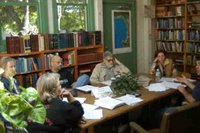CRITIQUE GROUPS

Getting a writing critique group up and running can be pretty dicey. I know. I’ve done it and it’s been fun and, at times, trying. But the group I belong to has been active for six years and is still going strong. Wanna know how to go about starting your own successful critique group? Read on ...
GETTING STARTED: The first thing to do is check around town and find active critique groups that are already up and running. See if they’re accepting new members. If they’re not, ask if you can sit in on one of their sessions to see if critiquing's right for you. This will give you ideas to help start your own group, and maybe even point out some dos and don’ts. If you find a group willing to accept you, great. If not — or if they’re not doing the kind of critique you want (non-critique, soft, hard, etc.) — it’s time to form your own. To get started you’ll need to find writers who are of the same mind as you. Most internet service providers (AOL, etc.) have member directories that list bios. Find people in your area that are interested in writing and shoot them an e-mail. Put flyers up at local bookstores, laundromats, and other billboard locations announcing the formation of a writers critique group (make sur e to put down your contact information, especially an e-mail address.) After you’ve got a sizeable number of people interested, find a meeting location — someone’s house, a coffee shop, a bookstore, your local library, etc. — and let your members decide on a date and time to meet (be aware that you won’t be able to get 100% consensus on this so don’t even try; go with the majority.)
e to put down your contact information, especially an e-mail address.) After you’ve got a sizeable number of people interested, find a meeting location — someone’s house, a coffee shop, a bookstore, your local library, etc. — and let your members decide on a date and time to meet (be aware that you won’t be able to get 100% consensus on this so don’t even try; go with the majority.)
YOUR FIRST MEETING: Time to set the ground-rules, and the members of your group should help formulate them. What type of critiquing do you want to do? How will submissions occur? Via the internet? Through the postal service? At the meetings? How many people can submit at one time? How long should the meetings be? How long should submissions be? How often should you meet? If there’s a point of contention (and believe me, there will be), how will it be solved? These are just a few of the items awaiting you during that first meeting. You shouldn’t do any critiquing here. This time is dedicated to the group’s layout and framework so that, later on, it’s smooth sailing.
SETTING UP CRITIQUING: You’ll need to arrange a critiquing schedule. If you’v e got only eight members, you might want half of them to submit one time and the other half at the next meeting. Much of this will depend on the number of members you have, how long the submissions are and how frequently you meet.
e got only eight members, you might want half of them to submit one time and the other half at the next meeting. Much of this will depend on the number of members you have, how long the submissions are and how frequently you meet.
DURING CRITIQUES: Critiques are not always easy to swallow. Having someone manhandle a beloved manuscript can cause blood pressures to rise and tempers to flare. To help keep critiques on a slow simmer, you should have the critiquers point out the positive aspects of the material before moving on to areas that "need improvement." This helps season the critique with equal parts good and not-so-good. Make sure the critiques don’t go on too long. Their focus should be on plot, prose, narrative flow and the overall quality of the story. Don’t get hung up on punctuation, spelling, grammar, etc. That’ll come later.

WHY CRITIQUE: Remember why you’re there: to help each other become more pr
 oficient at the art of writing. When giving and receiving critiques, make sure you keep that at the forefront of your gatherings. This will keep everyone focused and not devolve them into unnecessary bashings and hurting feelings. Remind members why you’re together ...often
oficient at the art of writing. When giving and receiving critiques, make sure you keep that at the forefront of your gatherings. This will keep everyone focused and not devolve them into unnecessary bashings and hurting feelings. Remind members why you’re together ...oftenCONTROLLING MEETINGS: Don’t let meetings spiral out of control. These sessions should not be social gatherings (although food and drink is good.) You’re here to help and be helped. When someone is giving a critique, there should be no interruptions, even from the author of the material. Everyone should finish their critiques uninterrupted and ONLY
 THEN should the author be allowed to speak. This will keep the meetings moving forward and prevent back and forth arguments, as well as ensuring critiques don’t come to a standstill.
THEN should the author be allowed to speak. This will keep the meetings moving forward and prevent back and forth arguments, as well as ensuring critiques don’t come to a standstill.BE POSITIVE: Even if you’re forced to review the worst "crap" you’ve ever read, put a positive spin on it. Tell the writer why you found the material unattractive and show them
 ways to improve. Don’t just say, "This is garbage!" and walk away. Remember, even amongst trash there is often a glimmer of something substantial. Point it out. Help them build their ideas. Get into their stories with them. This will show genuine interest and will make the writer feel valued. However, you should NEVER re-write someone’s story. This doesn’t help them at all. Authors often feel insulted if you re-write their work, and it doesn’t help them grow.
ways to improve. Don’t just say, "This is garbage!" and walk away. Remember, even amongst trash there is often a glimmer of something substantial. Point it out. Help them build their ideas. Get into their stories with them. This will show genuine interest and will make the writer feel valued. However, you should NEVER re-write someone’s story. This doesn’t help them at all. Authors often feel insulted if you re-write their work, and it doesn’t help them grow.ENDING MEETINGS: At the end of every session, make sure you thank everyone for coming and mention when the next meeting is and who’s going to be submitting. All the members then know what to expect. Surprises can cause conflict, so try to avoid them whenever possible.

Want to know how my group functions? Keep reading ...
Now that I’ve given you some ideas on how to set up a critique group, let me tell you about FWOMP (Fiction Writers of the Monterey Peninsula), the group I helped form and how we operate.
Our first meeting took place in January of 2000 at a local bookstore in Monterey. Over 30 writers showed up, which was waaaaaay too many. I was a bit freaked out by this because I had no idea that many authors in my area were looking for a critique group. And it turns out several of these weren’t really looking for what I was. They wanted this new group to "get them published." As soon as they learned we weren’t doing that, they drifted away, which still left us with about 25 people.
We’d decided to perform a short exercise to find out where everyone lay with respect to their writing abilities. What we did was put pieces of paper into a hat and pass it around. Everyone took one piece of paper and on them were written a person, place and thing (for instance, a prostitute, the Berlin Wall and a horse saddle ...don’t get kinky!) They were required to come up with a 1,000 word (maximum) short story which incorporated these three items and submit it to the group. This proved to be an excellent method for finding out where everyone’s writing strengths and weakness lay, and we all had a whooping good time writing and reading them.
As the next few months went by, we lost more writers and dwindled down to ten solid members. Our critiques, it was decided, would be hard-nosed. We weren’t going to be a social group, celebrating birthdays and meeting for holidays. We were dedicated to the written word and to helping each other improve our skills, come what may.
We decided to meet once a month — Saturday afternoons — for four hours. There would be three or four submitters per month and they would send out their submissions via e-mail attachment at least five days in advance of the meetings; submission length set at 15 pages, double-spaced, in Times New Roman 12-point font. This gave members time to critique stories in the comfort of their own homes, then come together at the selected meeting date and give a face to face critique. "Why not just do an online critiquing session?" you may be asking. Because much gets lost in translation during online critiques. Face to face forces you to address the author directly and for him/her to address you. Although this might not sound like a large issue, it is. Trust me. Try it and see.
Our meetings are lively and the discussions sometimes loud, but we’re respectful of one another and know our boundaries (after six years, we’d better!) For instance, if someone tries to respond while they’re being critiqued, another member will "shush" them or give them a friendly elbow in the side, a reminder that they need to wait until all critiques are finished before responding.
Critiques focus first on the positive aspects of the material before delving into the negative points. Always.
I know I mentioned earlier the trap of devolving into a social gathering, and although we aren’t a social group we do have social discussions at meetings. But we don’t let them take over our purpose, which is to read, write and improve our abilities.
Find out what FWOMP is up to by clicking here.



0 Comments:
Post a Comment
<< Home